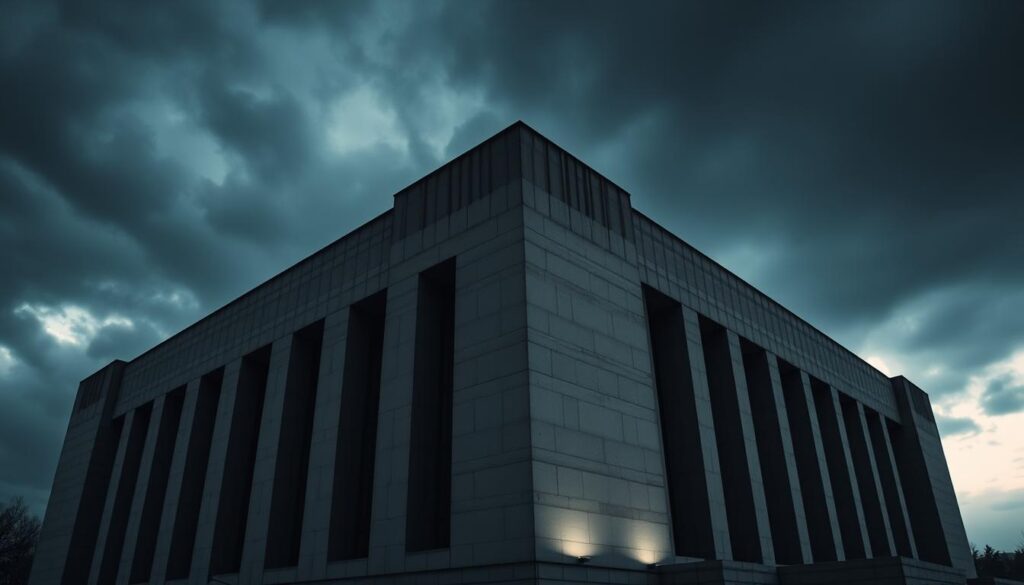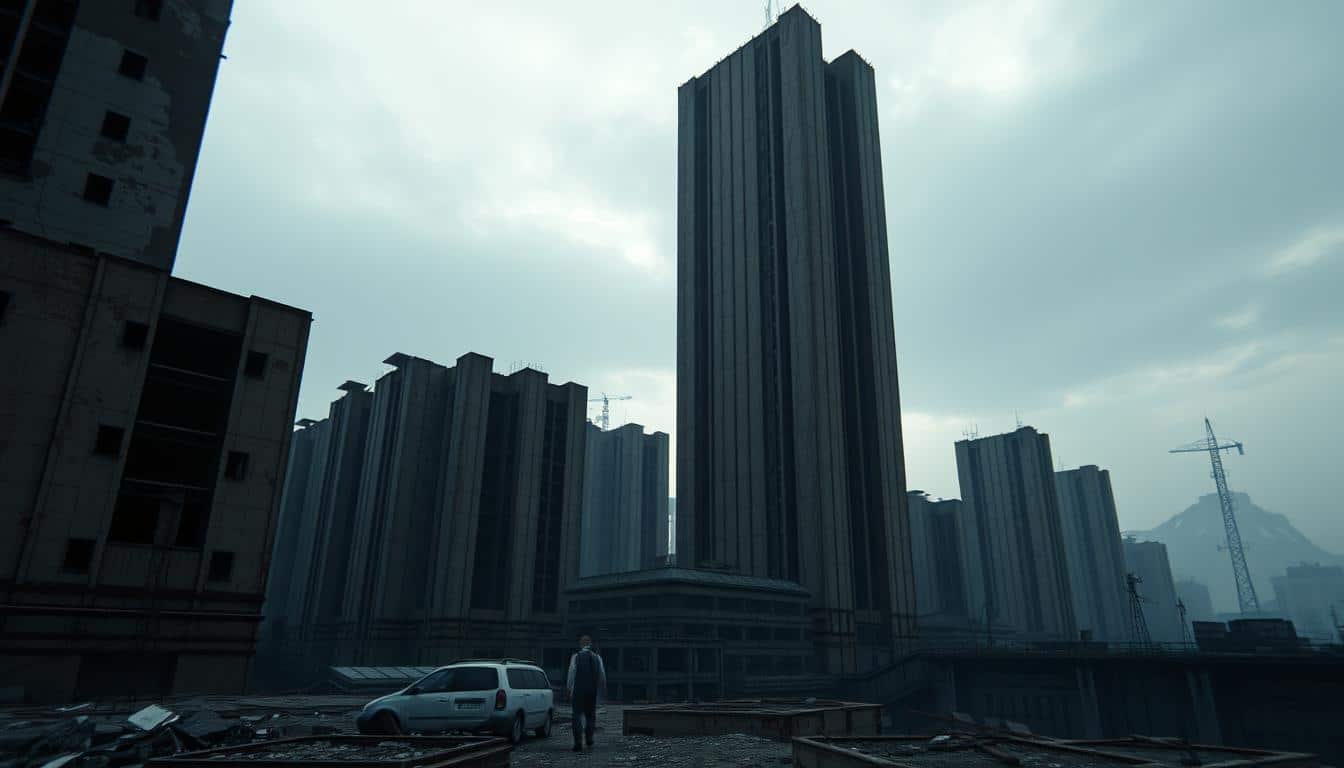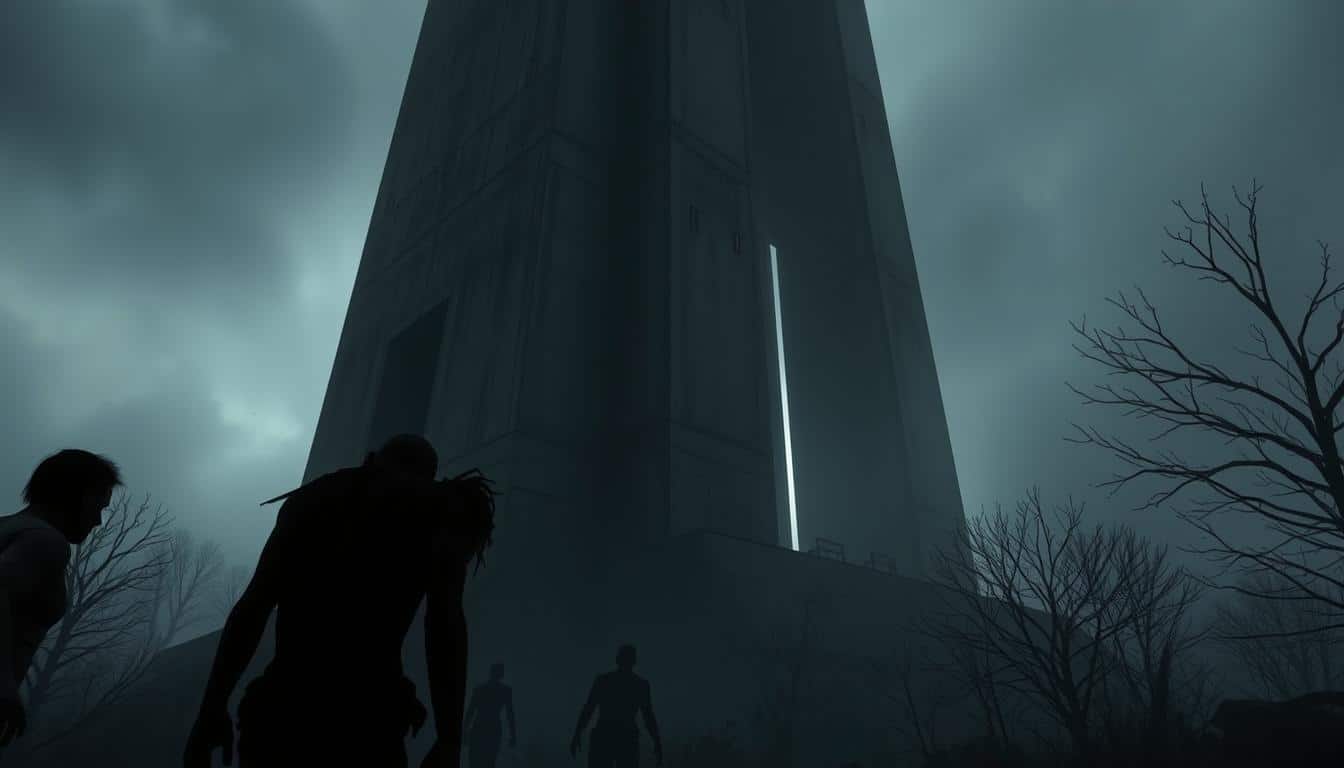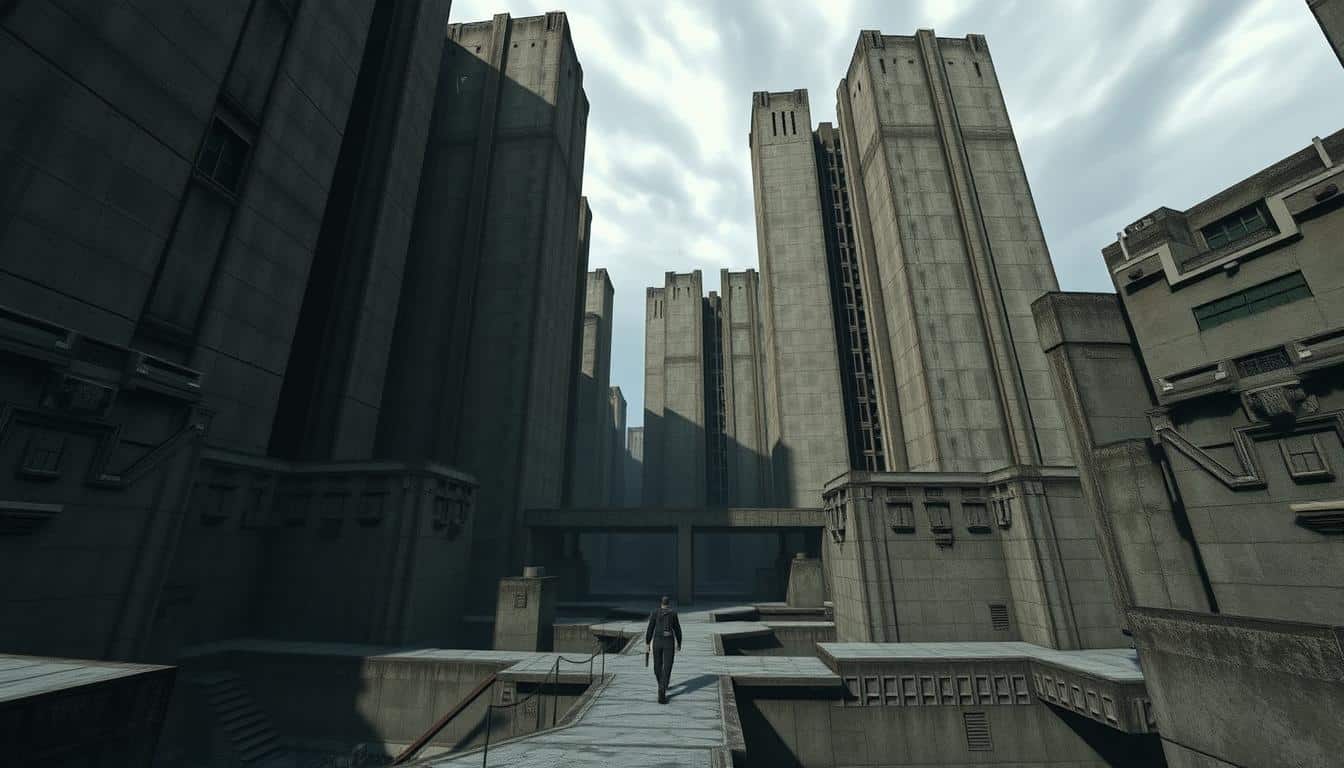Horror games often draw from deep influences. Soviet Brutalism is one huge influence. Its stark, heavy buildings add a dark vibe that fits right in with gaming. This style’s cold, big structures against the tension in games keep the fear going strong. It makes players face fears that feel very real.
Soviet Brutalism’s unique traits deeply impact horror games. Its tight hallways and silent, empty spaces make stories scarier. This adds a layer of unease that makes playing more intense. We’ll explore how this style deeply affects the game’s story and how it grabs players, pulling them into spooky, believable worlds.
The Rise of Soviet Brutalism
The post-war era brought Soviet Brutalism into the spotlight of architectural history. It emerged as an answer to the wreckage left by World War II. Its goal was to rebuild broken cities. The era’s history shows how closely politics and architecture were linked, putting practicality first.
Historical Context of Soviet Brutalism
Soviet Brutalism was more than a style; it reflected a shared belief. It emphasized function, mirroring the era’s communal focus. Cities in Eastern Europe embraced this, changing their horizons into signs of strength and togetherness.
Key Characteristics of Brutalist Architecture
Brutalist architecture is known for its stark use of concrete and simple look. The choice of concrete speeded up the building process. This allowed for fast housing and public space construction for people coming back home. These big, simple buildings put practical needs over looks, making them standout but useful.

Influence of Soviet Brutalism in Gaming
The horror genre in gaming has been deeply impacted by Soviet Brutalism. This style emerged as a key influence on game design and storytelling. Developers use the grim, powerful aspects of Brutalist architecture to craft environments full of fear and uncertainty.
Transitioning from Realism to Horror
There’s been a notable shift from realism to horror in gaming. The starkness of Soviet buildings sets the scene for eerie stories. These games use concrete and minimal interiors to create a feeling of decay. This boosts tension and deeply affects the player’s emotions.
How Architecture Shapes Game Environments
Architecture is vital in making horror games truly spooky. The tight spaces and large, cold walls make players feel trapped. This not only affects what players see but also how they play, as they move through places that feel confining. Brutalist spaces bring the fear to life, placing players in a scary, dystopian world.
soviet brutalism references in horror gaming culture
Soviet Brutalism has a big impact on horror games. Many games use this style to make their stories more creepy. They use Soviet themes to make players feel alone and scared.
Case Studies: Notable Horror Titles
Games like “Layers of Fear” and “The Medium” show how Soviet Brutalism can set a mood. The settings are bleak and remind players of tough government controls. This makes players feel lonely and scared.
- “Layers of Fear” makes you feel trapped with its tight spaces.
- “The Medium” combines a dark past with scary realities, making the fear deeper.
The Psychological Impact on Players
These games really affect players’ feelings. Being in places that look like Soviet buildings makes players tense and worried. This architecture brings up fears of control and fighting power. So, these games do more than scare you. They make you face deep fears.
The Role of Atmosphere in Horror Games
The atmosphere in horror games is key. It shapes how players feel. The game’s look is crucial for creating mood and tension. Think imposing structures and stark lines, like in brutalist architecture. These elements make players uneasy, making the game’s atmosphere more intense.
Creating Tension Through Visual Design
How a game looks is vital for a scary atmosphere. Spaces made of cold, hard materials look unsettling. Add in dim light and deep shadows, and you get real creepiness. This setting makes players feel alone and afraid, adding to the game’s psychological effect.
Soundscapes and Eerie Environments
Sound is just as important as visuals in horror games. Background noises, like far-off echoes or whispers, make everything feel abandoned and spooky. When sound and visuals work together, they turn ordinary places into scenes of horror. This mix captures what makes a horror game truly scary.
Bloober Team and their Unique Approach
Bloober Team has earned praise for mixing cultural stories into their games. They connect with players around the world by showing their Polish heritage. They aim to blend feelings of the past with fright in their games.
Integration of Cultural Heritage in Gaming
Cultural heritage is key in Bloober Team’s game-making strategy. They use Poland’s history to make their games real and captivating. This focus on their origins shows in the buildings and social topics in their games.
Case Study: Cronos: The New Dawn
The game Cronos: The New Dawn highlights Bloober Team’s unique methods. It’s set in 1980s Poland, featuring striking brutalist architecture. This style creates a mix of beauty and fear. The game not only entertains but also makes players think about the cultural stories behind it.
Parallels Between Soviet History and Game Narratives
Many horror games use Soviet history in their stories, giving players a look at past and present societal issues. This backdrop helps make the game feel more real. It draws players deeper into the experience.
Drawing Connections to Modern Society
Themes from Soviet history show up in today’s games, making a strong impact on players. These themes include control, loss of freedom, and the fight against oppressive powers. They let players explore worlds that feel like historical dictatorships.
In these games, players often see similarities to challenges in today’s world. This creates a deeper meaning for the game. It adds layers to the gaming experience.
Political Undertones in Gameplay Mechanics
Games also put political dilemmas into the gameplay itself. This makes players think about right and wrong. As they move through stories, they face decisions like those under harsh rule.
This mix of politics makes the story richer. It leads players to ponder their decisions in the game and in real life too.
Player Engagement with Soviet Era Themes
Horror games with Soviet themes offer a deep experience for players. These games make players face both personal and world history. They dive into tough worlds that show the hard life back then. As players move through these stories, they explore who they are and the big cultural ideas.
Exploring Identity Through Gameplay
Players really get into their characters in these games, looking into who they are. They might feel connected to the characters’ hard times caused by society and history. This makes them care more about the game, turning playtime into a look at their own selves. Survival, fighting hard, and not giving up are big themes. They make players think about their own lives through these stories.
Cultural Reflections in Character Development
Cultural stories are key to building characters in these games, making the stories richer. Characters deal with outside scares and inner fights, showing their complex backgrounds. Players go deep into these aspects, learning about both the horror parts and the social and cultural things that shape the characters. This approach helps understand the link between history and growing personally. It gives players a chance to think about their own cultural stories.
The Aesthetic of Brutalism in Game Design
The look of brutalism is key in horror games. It uses concrete and steel to make settings feel real and uncomfortable. This harsh, industrial style makes the game more immersive. It also highlights the special look of brutalism in games.
Using these materials, designers can create dense, engaging worlds. This pulls players in, often causing strong feelings. The heaviness of brutalist design makes the game’s tension higher, fitting for horror.
Utilizing Raw Materials in Visual Elements
Brutalism’s power comes from its raw materials. Game makers use these to make spaces that deeply connect players to the game’s feelings. Concrete and metal add unease and reality, readying players for intense moments.
Contrasting Brutalism with Other Art Styles
Comparing brutalism to other styles shows its unique effect. Others might use detailed or soft looks, weakening the emotional impact. Brutalism’s raw beauty delivers a stronger feel, perfect for horror stories. This comparison underlines brutalism’s vital part in making memorable game settings.
Conclusion
Soviet Brutalism plays a key role in horror games by shaping their stories and worlds. This style gives game developers a rich source of cultural insights to use. It helps them create stories that touch players deeply. When players see the bold designs of Brutalist buildings, they feel more inside the game’s world.
The future of gaming looks promising as horror games keep growing. Soviet Brutalism is not just for looks but also inspires new ways to tell stories. Game makers are getting better at blending these designs with gameplay. They’re tackling big themes that mirror real-world issues and personal fears.
Brutalist architecture brings together history and gaming culture in a unique way. It has become a major force in horror games today. As the genre gets bigger, using this architectural style will lead to memorable games. It lets players explore deep themes in a new way.



